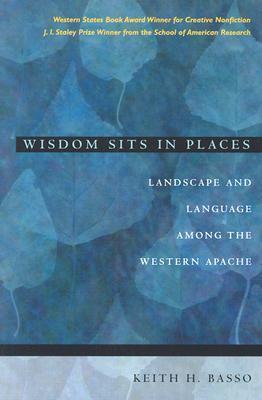What do you think?
Rate this book


192 pages, Paperback
First published August 1, 1996
Focusing mostly on the Western Apache, Wisdom Sits in Places revolves around a straightforward concept that can be difficult to entirely internalize even after reading the whole book, which is that the form of a place, and the naming of it, affect how we as people interact with it. Oh, the surface level of this is easy enough to understand. On the surface, the whole idea can be reduced to place names serving as a kind of shorthand for insightful anecdotes and parables that can be applied by the wise individual to real and present situations. Yet, in this guise, the book ought to be called Memory Sits in Places, not Wisdom Sits in Places. There is more to consider before the wisdom of places becomes evident.
Apache place names are wonderfully descriptive, almost like miniature poems describing a place instead of what we English speakers traditionally conceive of as proper nouns. The description might be of the physical characteristics of a place, or of an important event that transpired there, but either way it will serve as a reference for the entire community, who will be able to have entire conversations, communication vast volumes, by making short allusions to the place and its associated stories. I wonder if English names are less descriptive because of the many external influences on the language – I was reminded of how so many of our adjectives are actually place names from older tongues, like meander being the name of a particularly winding river in ancient Greece.
These naming customs also help explain and highlight the differing approach that the Apache (and many other Native American peoples) have to history compared to what we might visualize as the rigorous study of history. To the Apache, the idea of trying to capture some kind of “true” version of past events, like a replaying of what “actually” occurred, is rather nonsensical. Their history is tied up in the places they know and name, and the stories which those places and names embody. It is a form and understanding of history much closer to storytelling than to a semi-scientific discipline, in which the essence of what happens is more important than the supposedly objective facts. It’s a fascinating mindset, and it helps me further understand the hesitation expressed by some people about Zolbrod’s effort to write down the Diné Bahaneʼ.
What, though, does it really mean for wisdom to sit in a place? Basso gives us myriad examples and anecdotes, and explores the Apache idea of wisdom, but he is not prepared, at least in this book, to dig more deeply into the question. He does not explore other cultures’ ideas of wisdom and its ties to locality, and he does not back out from his focus on the Apache to examine more broadly the human mental relationship with the environment. In that sense, I think the book could have benefited from being twice as long, or even longer, to explore these ideas more thoroughly. I remain convinced that the way we perceive our environments affects how we think, and that how we think affects our environments, in an inextricable way, and what Basso highlights about the Apache brings me closer to more fully realizing that notion.
A little like The Cutting-Off Way, this book is also a collection of extended, scholarly essays that were published independently before being gathering together into a single text, but that does not detract from the overall integrity of the book, nor from the reading experience. This is both scholarly and anecdotal, a blend of ethnography, history, philosophy, and memoir, with all of it interesting. However you come to it, I think you stand to gain fresh insight from reading Wisdom Sits in Places.